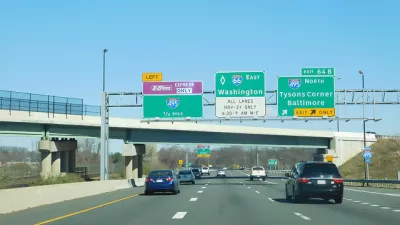The lanes are in use now, operating as High Occupancy Vehicle (HOV) lanes during peak hours. Come December, solo-occupant vehicles will be able to use the converted lanes, providing they have E-ZPass transponders. However, there are some losers.
The losers are those with "Clean Special Fuel plates," e.g., hybrids and electric vehicles, which have been using the HOV lanes by solo drivers. The Virginia Department of Transportation refers to these low or zero emission vehicles generically as "hybrid vehicles." In California, traditional hybrid vehicles, without plug-in battery charging capability, lost their special privileges over six years ago.
Come December, all "clean fuel" vehicles will need to have at least one passenger to use the I-66 HOT lanes toll-free, according to Luz Lazo, transportation reporter for The Washington Post, who has been chronicling the new lanes since at least July.
The new 10 miles of HOT lanes on I-66 are "inside-the-Capital Beltway," from Route 29 in Rosslyn to Interstate 495.
Unlike the 495 and 95 Express Lanes in Northern Virginia that operate 24-7, the I-66 HOT lanes will only function during peak hours and in the peak direction, i.e., they will operate like general purpose lanes during all other times. However, those hours have been expanded. "The new peak hours will be 5:30 to 9:30 a.m. eastbound and 3 to 7 p.m. westbound."
For commuters, adjusting to the new requirements and rules may be the biggest challenge in coming months. This will be the first rush-hour-only, peak-period toll system of its kind in the United States.
All vehicles except motorcycles that use the HOT lanes will need to have E-ZPass accounts. Carpoolers will need to switch to "HOV mode."
Planetizen has also been chronicling the conversion and addition of the new HOT lanes with five posts since June 2015.
Hat tip to Kenyon Karl.
FULL STORY: Virginia’s latest experiment with toll lanes to test thousands of commuters on I-66

Maui's Vacation Rental Debate Turns Ugly
Verbal attacks, misinformation campaigns and fistfights plague a high-stakes debate to convert thousands of vacation rentals into long-term housing.

Planetizen Federal Action Tracker
A weekly monitor of how Trump’s orders and actions are impacting planners and planning in America.

Chicago’s Ghost Rails
Just beneath the surface of the modern city lie the remnants of its expansive early 20th-century streetcar system.

Bend, Oregon Zoning Reforms Prioritize Small-Scale Housing
The city altered its zoning code to allow multi-family housing and eliminated parking mandates citywide.

Amtrak Cutting Jobs, Funding to High-Speed Rail
The agency plans to cut 10 percent of its workforce and has confirmed it will not fund new high-speed rail projects.

LA Denies Basic Services to Unhoused Residents
The city has repeatedly failed to respond to requests for trash pickup at encampment sites, and eliminated a program that provided mobile showers and toilets.
Urban Design for Planners 1: Software Tools
This six-course series explores essential urban design concepts using open source software and equips planners with the tools they need to participate fully in the urban design process.
Planning for Universal Design
Learn the tools for implementing Universal Design in planning regulations.
planning NEXT
Appalachian Highlands Housing Partners
Mpact (founded as Rail~Volution)
City of Camden Redevelopment Agency
City of Astoria
City of Portland
City of Laramie




























